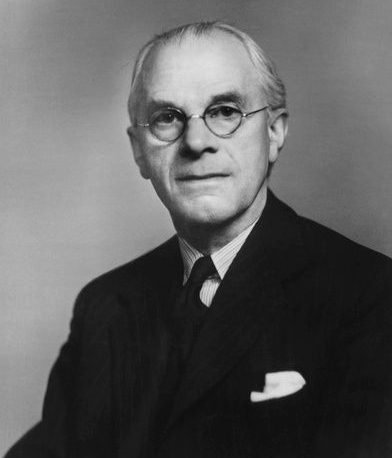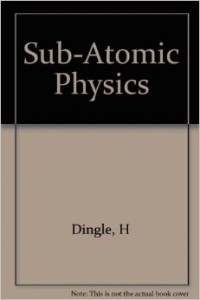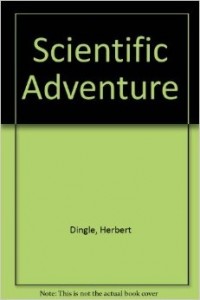Herbert Dingle was a 20th century physicist, philosopher and historian of science, author of scientific books, and an untiring critic of science and scientific method. He is best known for his criticism of the special theory of relativity, stemming from controversies over the twins paradox in the 1950s, and his book Science At The Crossroads which documented how the scientific community attempted to suppress his heterodox viewpoint. He is most famous for his assertion that the special theory of relativity contains a logical or mathematical inconsistency which invalidates it.
Dingle was born in London August 2, 1890, of Cornish ancestry. He was raised in Plymouth by his mother, who moved there following the death of his father. He left school at age fourteen in order to work, but he continued his studies at night. In 1915 at age 24, he won a Royal Scholarship for physics at Imperial College, London. He was appointed to the department staff there prior to his graduation in 1918, and remained at Imperial College for many more years, eventually leaving in 1946. Upon graduation he was married to Alice Westacott. They had one son. Both died before Dingle, who died in Hull on September 4, 1978 shortly after his 88 birthday.
Dingle was an academic by profession. He trained to be a physicist, and worked in the field of spectroscopy. At imperial College he worked in the department where Norman Lockyer had been section head, followed by Alfred Flower. Dingle became spectroscopy section head in 1935. In 1937 he was appointed to a chair in Natural Philosophy in the physics department. During the second world war, Dingle took responsibility for running of the physics department in the absence of its formal leader. In 1946, Dingle left Imperial College to take the position of Professor and head of the History and Philosophy of Science department at University College, London. He remained there until he retired in 1955. He was highly regarded as one of the foremost philosophers of science in Britain.
He was elected a fellow of of the Royal Astronomical Society in 1922, as a result of his spectroscopy work, he was elected president of The Royal Astronomical Society in 1951, serving until 1953. He was President of the History of Astronomy Commission of the International astronomical Union. In 1948 Dingle founded the Philosophy of Science Group of the British Society for the History Of Science, and in 1950 founded its official journal the British Journal for the Philosophy of Science. From 1955 to 1957 he was president of the British Society for the History of Science.
Dingle’s professional work can be divided into three areas: spectroscopy and astrophysics, natural philosophy, and relativity. In the case of relativity, his most famous work occurred after his retirement.Dingle studied spectrochemical analysis and pioneered research into Flourine II and III. In 1924 he published one of the earlier books in astrophysics with the title Modern Astrophysics. In 1923 a book entitled Splendor Of The Heavens was published with Dingle as one of its authors. In 1929 he published The Life and Work Of Sir Norman Lockyer who had once headed Dingle‘s own spectroscopy department. By the 1930s, Dingle’s main emphasis had shifted from physics to philosophical interests, although he maintained his physical work until he left Imperial College.
Dingle developed an interest in natural philosophy from Alfred North Whitehead. Who from 1910 to 1922 taught and wrote on physics and the philosophy of science while at Imperial College and University College, London. Dingle describes his development in natural philosophy in this way: “I grew to adolescence at a time when theoretical physics was just in the state to make most appeal to a mind eager for activity of all kinds and hovering chiefly between the delights of literature and the discipline of abstract thought… when, in later years the clouds of relativity and quantum theory filled the sky, and I had the good fortune …to be for a few years a pupil of Professor Whitehead’s, I determined to work out for myself a rational scheme of thought in which these fantastic physical developments would appear as intelligible…in other words, to seek a philosophy into which science …would find a rational setting.†This was Dingle’s lifelong goal.
His first book devoted to natural philosophy titled Science and Human Experience was based on a lecture series and was published in 1931. His second book Through Science To Philosophy, published in 1937 continued the theme. In his first book he was critical of the new scientific philosophies in particular those of Eddington and Jeans. His second book was more detailed in defining a scientific philosophy which Dingle advocated. This was more of an empirical science, that was based upon a real understanding of the world rather than a speculative science that was long on a theory of mathematical speculation and short on real empirical facts about the world as it is. This theme, that science should be an empirically based enterprise rather than a mathematically speculative enterprise was the hallmark of his scientific philosophy and was one of the sources of his criticism of relativity.
![.Herbert Dingle University of Chicago Photographic Archive, [apf digital item number, apf6-04362], Special Collections Research Center, University of Chicago Library.](http://www.naturalphilosophy.org/site/harryricker/wp-content/uploads/sites/50/2015/05/t.jpg)
Dingle tells us that he studied natural philosophy under Alfred North Whitehead. Apparently it was Whitehead who persuaded him that relativity was a worthy subject of interest. In 1922 he published his first relativity book Relativity For All. It was a popular exposition that appeared at the height of popular interest in relativity following the eclipse expedition of 1918, in which Dingle participated, which declared that the theory had been proven. In 1940, Dingle published his second relativity book titled, The Special Theory Of Relativity. This was an intermediate level textbook to introduce relativity to college students, that was highly successful, although it was attacked by mainstream relativists who tried to suppress it. His third and last book Science At The Crossroads appeared in 1971. It documents his challenge to the relativity establishment regarding his claims of an inconsistency in the theory and the methods used to suppress his view, without answering the challenge to prove that his claims were false.
Dingle’s claim of an inconsistency in the special theory of relativity occurred after many years of controversy were already behind him. The first controversy erupted in 1939 when he published a paper in Nature which asserted that it was not correct to state that according to relativity moving clocks run slow. His argument was based on his discovery of a mathematical demonstration that there were clocks that did not obey this claim. He was subsequently attacked for this claim and a bitter exchange of letters occurred in the pages of Nature. The essence of the controversy was the claim by Dingle’s critics that his demonstration did not use a legitimate clock and therefore was invalid. Dingle resisted this assertion and stuck to his claim. He asserted that the claim of relativity should be changed to assert that it was the time scale of physics that was changed by relative motion and not the rate of a particular type of clock. He asserted that this did not invalidate relativity, but that it showed a need to correct the calibration of clocks that did not obey the time transformation law of relativity.
In 1940 the controversy was revived by Paul Epstein who used it as an opportunity to criticize Dingle’s book the Special Theory of Relativity. Another acrimonious exchange of letters occurred, but this time in the American Journal Of Physics. The issues of the previous debate were revisited by Epstein who added an additional major criticism of Dingle‘s book, that it did not teach the operational method. The issues discussed included the adequacy of the operational method, the reality of the Lorentz contraction, and the legitimacy of Dingle’s clocks. Eventually Einstein’s protégé, Leopold Infeld, published a paper which appeared to resolved the dispute by asserting his agreement with Paul Epstein. However, none of the disputed issues were actually resolved.
In 1955 Dingle precipitated the most famous of his controversies when he objected to a statement made in a book written by George Thompson The Foreseeable Future regarding the famous twins paradox. The ensuing controversy was one of the most famous disputes in 20th century physics. The controversy caused Dingle to investigate the mathematical and physical foundations of the special theory of relativity and this caused him to doubt its validity. Eventually he discovered mathematical demonstrations which he interpreted as proof of flaws in or inconsistencies in the theory. The debate and discussion of these eventually led him to disown relativity as a valid scientific theory and produced his long campaign to establish his refutation of relativity as scientifically valid, which remained his main goal for the rest of his life.
What Dingle discovered in this controversy is different from what the establishment critics of Dingle say about it. They claim that he was wrong, but that claim can not, and has not, been proved, despite the fact that they claim it is not true. Dingle asserted that there must be a flaw in the theory. This claim was mitigated by an additional assertion on his part that the mathematics was correct. This has been the source of considerable confusion and controversy. Clearly Dingle did not mean that all the mathematics was correct, because he used the established mathematics to present a logical contradiction. What he meant was that assuming that the mathematics was correct, we deduce a logical contradiction — Dingle politely called this an inconsistency–, which must be the result of a flaw within the theory. According to Dingle this flaw was within the logical structure and not within the
mathematical structure.
To illustrate this, consider Dingle’s 1962 letter to Nature which claimed an inconsistency. In this letter, Dingle showed that by the method used by Einstein, it was just as valid to conclude that moving clocks run fast as to conclude that they run slow. Although Dingle called it an inconsistency, it was really an logical or mathematical contradiction, similar to the other inconsistencies which were labeled as paradoxes in the theory of relativity. Succinctly put, Dingle had discovered another paradox. But it was essentially the same as the clock paradox, which had been discovered much earlier, but it was a more precise statement of it.
To understand this clock paradox problem, and how the Dingle paradox were related, consider the following. The clock paradox arises from Einstein’ 1905 paper where he states that if a synchronized clock is moved from some location to another one in the same reference frame, its motion causes it to lags behind the clocks clocks in the same frame that do not move. This conclusion, however, implies a contradiction of the principle of relativity, which asserts an equivalence of reference frames. Hence, it is not logically possible to say that one clock was the one that moved and not the opposite one in the other frame. Hence, it was not possible o say which clock, if any , actually lagged in time after being moved. Dingle’s paradox asserted that given any clock being moved, is was not possible to say whether the motion caused it to lag behind or to accelerate ahead of the rest clock to which it is compared.
Dingle said that this dilemma had a simple solution. Neither clock was changed by the motion, hence there would be no difference in their readings after the motion, if there was no difference before being moved. This simple answer should have been recognized as the correct solution, but instead was claimed to be wrong. Primarily because of the recourse to experimental evidence which seemed to imply that the moving clock actually ran slow and not fast so Dingle seemed to be clearly wrong. But this answer didn’t resolve Dingle’s paradox, it just preempted it as a perceived problem within the theory. The reason for this is not difficult to surmise, it pointed to evidence that the special theory of relativity was contradicted by experiment, hence recourse to the conclusion that experiment confirmed relativity instead
What Dingle exposed, and the reward for this was eternal damnation in the eyes of the science establishment, was that relativity was unable to prove whether its claim that moving clocks run slow is true within the mathematical and logical structure of the theory, without recourse to experiment. This point has not been carefully studied, because most scientists incorrectly assume that Dingle has been proved wrong. But there is no proof of this, just hearsay. Hearsay is not proof, but apparently in science it can be if the claim is seriously a problem. Dingle showed that the relativistic claim is ambiguous. It is just as valid to claim that moving clocks run fast as to claim that they run slow. No proof can be produced that resolves this difficulty. Relativity is ambiguous, it is as valid to claim clocks run fast as slow. Dingle demanded an answer, but none was produced, si that claim is essentially unproven.
![]()







